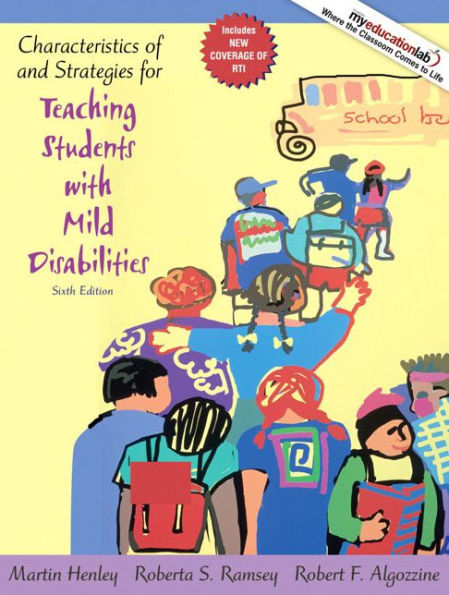Table of Contents
Chapter One
Foundations of Special Education
Chapter Outline
Roots of Special Education
Diversity
Ending Handicappism
Litigation and Legislation
Federal Laws
Individuals with Disabilities Education Act
No Child Left Behind Act
Who Receives Special Education?
Physical/Sensory Disabilities
Cognitive Disabilities
Academic Disabilities
Communication Disabilities
Emotional Disabilities
How Many Students Receive Special Education?
Students with Mild Disabilities
Learning Disability
Mild Intellectual Disability
Emotional Disability
Labeling
Advantages of Labeling
Disadvantages of Labeling
What to Teach Students
Individual Education Plan
Where to Teach Students
How to Teach Studens
Summary
Activity
Chapter Two
Students with Mild Disabilities
Chapter Outline
Cross Categorical Characteristics
Attention Deficit Hyperactivity Disorder
Pervasive Developmental Disorder
Asperger’s Syndrome
Nonverbal Learning Disability
Causes of Mild Disabilities
Organic Causes
Environmental Causes
At-Risk Populations
Due Process Procedures
Prerefferal
Referral
Evaluation
Response to Intervention
Summary
Activities
Chapter Three
Students with Mild Intellectual Disabilities
Chapter Outline
Foundations
Lloyd Dunn
Alfred Binet
History of Intelligence Testing
Definition and Identification
The Six Hour Retarded Child
Types of Intellectual Disabilities
Prevalence
Causes of Mild Intellectual Disabilities
Organic Causes
Environmental Causes
Disproportionate Representation of Minorities
Characteristics
Cognitive
Mental Processing
Academics
Communciation
Perceptual/Motor
Social/Adaptive
Teaching Approaches
Instructions
Thinking Skills
Reading
Functional Skills
Adaptive Behavior
Daily Living Skills
Summary
Activities
Chapter Four
Students with Emotional Disturbance
Chapter Outline
Foundations
Historical Perspective
Definition and Identification
Issues and Concerns
Levels of Emotional Disturbance
Prevalence of Emotional Disturbance
Attention Deficit Hyperactivity Disorder
Causes
Biophysical
Psychodynamic
Psychoeducational
Behavioral
Disturbed or Disturbing
Ecological Model
Characteristics
Cognitive
Achievement
Communication
Social Adaptive
Positive Behavior Support
Integration of Treatment Approaches
Cultural Diversity
Summary
Activities
Chapter Five
Students with Learning Disabilities
Chapter Outline
Foundations
Early Research
Brain Research
Causes of Learning Disabilities
Definition and Identification
Prevalence
Characteristics
Cognitive
Mental Processing
Academics
Communication
Perceptual-Motor
Social/Adaptive
Teaching Approaches
Psychological Model
Behavioral Model
Cognitive Model
Young Adults
Summary
Activities
Chapter Six
The Inclusive Classroom
Chapter Outline
Least Restrictive Environment
Court Cases
Organizing Inclusion Programs
Collaboration
Characteristics of Collaboration
Inclusion Models
Consulting Teacher
Co-Teacher
Co-Teaching Plan
Co-Teaching Tips
Collaborative Instruction
Peer Tutoring
Cooperative Learning
Common Ground
Teacher Expectations
Classroom Organization
Standardized Tests
Summary
Activities
Chapter Seven
Learning and Teaching
Chapter Outline
Today’s Schools
Student Perception
Child and Adolescent Development
Student Centered Learning
Brain-Compatible Instruction
Emotions and Learning
Multiple Intelligence
Instructional Models
Direct Instruction
Multi-Sensory Instruction
Differentiated Instruction
Task Analysis
Precision Teaching
Learning Strategies
Instructional Scaffolds
Technology
Assistive Technology
Functional Curriculum
Comprehensive Teaching
Summary
Activities
Chapter Eight
Instructing Students with Mild Disabilities
Chapter Outline
Best Teaching Practices
Time Management
Academic Learning Time
Selecting Instructional Materials
Teacher and Student Communication
Graphic Organizers
Student Organization
Student Performance
Instructional Accommodations, Modifications, and Strategies
Accommodations Using Technology
Testing and Grading Accommodations
Test Taking Skills
Testing Accommodations
Curriculum Based Assessment
The Educator’s Tool Kit
Summary
Activities
Chapter Nine
Classroom Management
Chapter Outline
Discipline: An Overview
Proactive Discipline
Teacher Values
Teacher Needs
Know Your Students
Classroom Organization
Positive Behavior Support
Functional Behavior Assessment
Managing Student Behavior
Behavior Modification
Nonverbal Interventions
Verbal Inteventions
Managing Conflict Situations
Life Space Crisis Intervention
Discipline and IDEA
Punishment
Theory into Practice
Summary
Activities
Chapter Ten
Teaching Social Skills
Chapter Outline
Emotional Intelligence
Teaching Social Skills
Selecting A Curriculum
A Sample Social Skills Curriculum
Impulse Control
Assessment of Social Reality
Managing Group Situations
Stress Management
Solving Social Problems
Character Education
Moral Development
Sociometrics
A Functional Model for Problem Behavior
Summary
Activities
Chapter Eleven
Building Family Partnerships
Chapter Outline
America’s Children
Family Members and Teachers: Valuable Partners
Understanding Families
Feelings
Family Unit
Support for Families
Emotional Support
Information
Government Programs
Teacher-Family Communication
Conference
Telephone
Written
Technology
IEP Meeting
Summary
Activities






